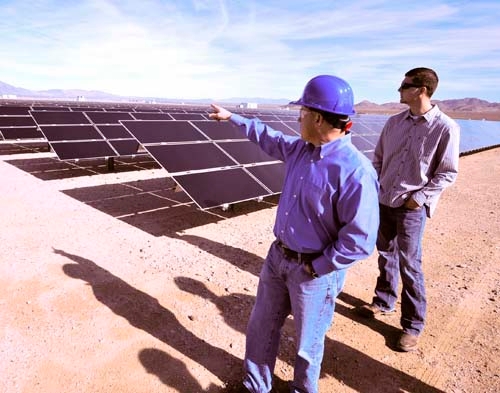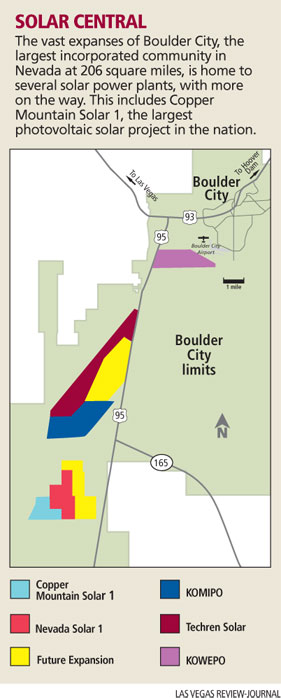Solar projects take home of Hoover Dam back to future



The small town of Boulder City can claim big-time bragging rights when it comes to producing renewable energy. Leading the nation will do that for a community.
But solar power has generated more than electricity in Boulder City. The industry has and will continue to generate significant revenue for the city through lease payments.
So much so that Mayor Roger Tobler in his recent State of the City address said the solar projects have the potential to eliminate the city’s debt and stabilize its revenue stream far into the future.
Because of this money, Boulder City is being spared many of the drastic spending cuts that other Nevada cities have been forced to deal with because of the economic downturn, including layoffs, furloughs and pay cuts and freezes.
GREATEST STORY NEVER TOLD
According to City Manager Vicki Mayes, the city will collect a total of about $12 million a year just in lease payments, and that figure doesn’t account for one solar company still in negotiations.
She made it clear that most of that money is not yet headed to city coffers; but once projects now in the planning stage begin to produce solar energy, that $12 million will be a reliable source of revenue for decades.
The companies also were required to provide "large upfront payments" to cover the two- to four-year construction period.
In a nutshell, the city stands to collect more than $480 million in rent through the life of the contracts. Tobler said the lease payments have the potential to eliminate the city’s debts and it’s difficult to argue with the council’s optimism. In 2011, the city’s budget was roughly $25 million with an ending fund balance of about $2 million. The leases currently in effect will increase the city’s revenue by nearly 50 percent.
Mayes said the briefest lease is for 20 years with an option to extend it another two decades while the others range between 40 and 50 years.
Clark County will also benefit from the property taxes the companies will pay to the tune of hundreds of thousands of dollars annually. Some of that revenue will come to the city.
Tobler credits his colleagues on the City Council and those who served on past councils for having the vision to embrace solar projects. He believes the hard work has once again put the city on the cutting edge of new energy technology.
Of the two projects already in operation, one is the largest photovoltaic solar project in the nation; the other is the first large-scale concentrated solar power plant built in 15 years. Photovoltaic technology turns the sun’s rays directly into electricity. Concentrated power plants use the sun’s heat to power a conventional turbine, which generates electricity.
"This is the greatest story never told," he said. "What we’re doing is huge. I have to credit my predecessors with having the foresight to move ahead. We’re just continuing what they started."
Tobler also praised the residents of Boulder City for their near unanimous support of the projects.
"It helps to have companies with good track records," he said.
INTERNATIONAL AFFAIR
Woo-Jin Kim, a South Korean who attended UCLA and who now lives in Las Vegas, introduced three Korean solar companies to the city and helped facilitate their projects. Two have been approved and one is "very close" to being negotiated, Tobler said. When all is said and done, five companies from three countries will play a role in Boulder City’s energy zone.
"Boulder City did a very smart thing," said Kim said.
Because the city owns the land on which the land-intensive projects are built, he said, those companies largely avoided the lengthy process and heavy expense of building on federal land under the control of the Bureau of Land Management.
"The bureau’s environmental impact studies take three or four years and the permits cost ($5 million to $6 million)," Kim said. "Boulder City did its due diligence in terms of who they do business with and the environmental impact, but the fact Boulder City doesn’t require the environmental studies makes it a very preferable situation for Boulder City and the solar companies."
Kim said city officials have put out the welcome mat. "The Koreans tell me they don’t feel like they’re doing business in a foreign country. The city is very forward thinking, and officials like (City Manager) Vicki Mayes are very knowledgeable and wonderful to work with."
That’s an opinion shared by Bob Cable, the plant manager at Nevada Solar 1, a company owned by Spanish company Acciona, which built the first solar project in the city.
"They had the forethought to plan ahead," Cable said. "We lease the land from them. We’re able to profit and Boulder City gets a pretty healthy payment every year."
Nevada Solar 1 has a 50-year lease agreement with the city for about 400 acres.
Two of the Korean companies Kim’s management firm represents, KOMIPO and KOWEPO, will make upfront payments to the city of $5 million and $3.5 million, respectively, to cover rent while the facilities are built on sites ranging from 900 to 2,200 acres.
In addition to its lease payments, Sempra gave the city $500,000 to upgrade its public buildings using "any type of renewable energy," Tobler said in his State of the City address Jan. 26.
PAST IS PROLOGUE
The city, about 25 miles south of Las Vegas, was built in 1931 for one purpose: to house thousands of workers to construct Hoover Dam during the Great Depression. Back then, the dam was the largest hydroelectric power plant project in the nation, producing 1,345 megawatts of renewable energy to vast swaths of the Southwest. Today, the dam generates an average of 2,080 megawatts .
More than eight decades after construction began on the dam, Boulder City’s Eldorado Valley is rapidly becoming the epicenter of the nation’s solar power generation. Copper Mountain Solar 1 is the nation’s largest photovoltaic solar power plant. The plant is owned by Sempra U.S. Gas & Power and produces 58 megawatts.
Across the street is Acciona’s Nevada Solar 1, a 65-megawatt concentrated solar power facility constructed in 2007. At the time, it was the first major solar operation built in the United States since 1991.
Both companies plan significant expansions, but they are far from the only solar game in Boulder City. About 8,000 acres were set aside to develop the city’s "energy zone." Tobler said just about every acre has been claimed by one company or another.
Techren Solar, the third Korean company Kim represents, plans to develop a 300-megawatt facility.
TRIFECTA OF SUN, LAND AND LINES
And just as engineers found nearby Black Canyon an ideal place to build Hoover Dam all those years ago, today’s generation of renewable energy companies consider Boulder City one of the best places in the world to set up shop.
"Boulder City is more attractive to solar companies than anywhere else," said Scott Crider, Sempra’s director of external relations. "There is more sunlight here, plenty of land and available transmission lines."
Sure, there’s just as much sunlight in other areas of the Southwest, more than 300 sunny days a year in most places. But few communities are situated so close to a significant power grid, and fewer still have thousands of acres of empty land just waiting for a developer.
The city might be one of the smaller communities in Southern Nevada with about 15,000 residents, but it’s a giant in geographic terms.
They city’s boundaries take in roughly 200 square miles, making it the largest incorporated community in the state. To put that in perspective, 640 acres constitute one square mile.
In comparison, the city boundaries of Las Vegas comprise about 136 square miles, and Las Vegas is home to about 584,000 residents.
RAPIDLY CHANGING INDUSTRY
Solar power is here to stay.
Four years ago, the largest photovoltaic facility in the nation produced 10 megawatts of electricity. One megawatt is equal to 1 million watts. Sempra’s next project in Boulder City, Copper Mountain II, will be a 150-megawatt operation.
"We’ve gained a lot of experience since 2008," Crider said. "We’ll be able to build it in less than a year, panel costs continue to drop and we’re getting more efficient all the time. Solar is a maturing industry."
Crider said he couldn’t divulge the precise cost to build Copper Mountain 1, but he did say it averaged between $3 million and $4 million per megawatt, or close to $203 million.
Currently, Sempra and Acciona are producing a little more than 120 megawatts of solar power. That’s enough to provide power to about 40,000 homes.
And both companies enjoy long-term contracts. Sempra has sold its solar energy to San Francisco-based Pacific Gas & Electric, serving Northern California, while Acciona is contracted with NV Energy.
When the other companies go online, about 1,400 megawatts will be generated, enough to provide electricity to roughly 420,000 homes.
Crider acknowledges it is less expensive to generate power using fossil fuels like oil and coal, but he thinks the balance will even out sooner than many people suspect it will.
"We’re getting more competitive," Crider said. "In 20 years future Boulder City councils will thank Mayor Tobler and the council for what they’ve done. Boulder City has a history of being pro clean and green energy, and it goes back to Hoover Dam."
"No headaches yet," Tobler said. "We think this is going to work out well, and we think the city will benefit along with the environment."
Contact reporter Doug McMurdo at dmcmurdo@reviewjournal.com or 702-224-5512.












